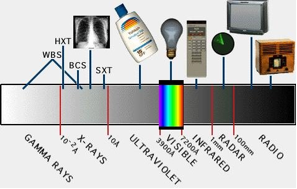The diurnal ionosphere
Solar spectrum
<menu30>
The solar spectrum extends on a broad range wavelengths, since the tenth of nanometer (nm) until the meter. In the visible one - with 390 to 760 Nm, it radiates with a maximum around 450 Nm, i.e. in blue. Let us not mistake ! The Sun is not blue for as much ! The mixture of all the colors, the absorption of the light by the terrestrial atmosphere, as well as the sensitivity of our eyes show it to us yellow (and red with sleeping). This part of the spectrum was studied since the 19th century.

du satellite japonais d’observation du soleil YOKHOH.
Elle montre les diverses longueurs d’ondes
avec leur nom en dessous de l’image.
Au dessus, on voit les produits du commerce qui y sont associés.
A gauche, les sigles WBS, HXT, BCS et SXT
correspondent aux instruments à bord du satellite.
Nevertheless, the visible light has little importance for the high aeronomy in comparison with the ultra-violet (100 to 390 Nm) or the extreme ultra-violet (20 to 100 Nm). The first are indeed enough energy to excite the atmosphere, while the seconds can in addition ionize it, i.e. to tear off one or even several electrons of an atom or a molecule. These wavelengths are stopped above typically 80 km of altitude. It is thus not astonishing that it was necessary to wait one recent period to measure the spectrum of it : when Planck, in 1901, presented its theory of the black body, it was far from suspecter the presence, in the tail of distribution, of such an intense radiation.
The first spectrum in these ranges wavelengths was obtained in 1946, during first experiments on board rockets. In 1977, a compilation gave place to a first spectrum of theoretical reference. However, measurements had shown the great variability of radiation U.V according to the solar activity. During the same time, three American satellites of the series Dynamics Explorer carried spectrographs of observation in the ultra-violet. Unfortunately, only Dynamics Explorer E was in a position to function. Even if good progresses thanks to this instrument were considerable, an main issue lay in the fact that these flows were relative : there was no calibration on board. The absolute values were obtained while comparing with simultaneous measurements on board rockets, then, on the long run by correcting the estimated instrumental drift of the embarked spectrograph.
From 1980 to 1988, there was no embarked instrument measuring this flow. One been able to speak, to describe this period, of “hole of U.V.” ! The satellite San Marco joined again with this measurement in 1988. On board satellite SOHO, not less than four instruments parts of the solar spectrum observe in the extreme ultra-violet. Unfortunately, several of them are not calibrated, so that at this beginning of century, we are always unable to say, at a given moment, how much these very energy photons bombard our planet. In March 2001, perhaps a piece of the veil will tear it with the launching of American satellite TIMED.

Updated on 30 mars 2012




